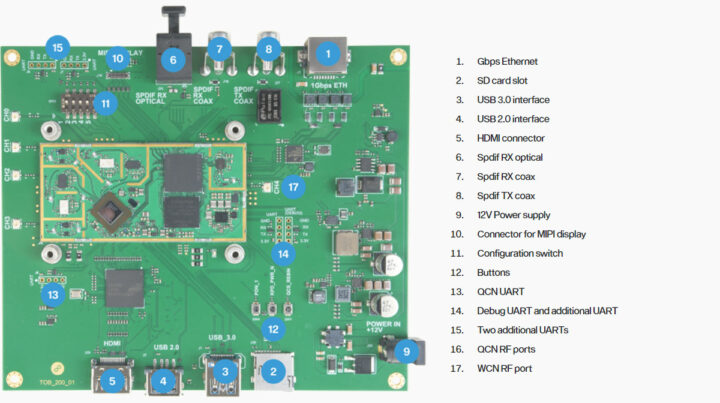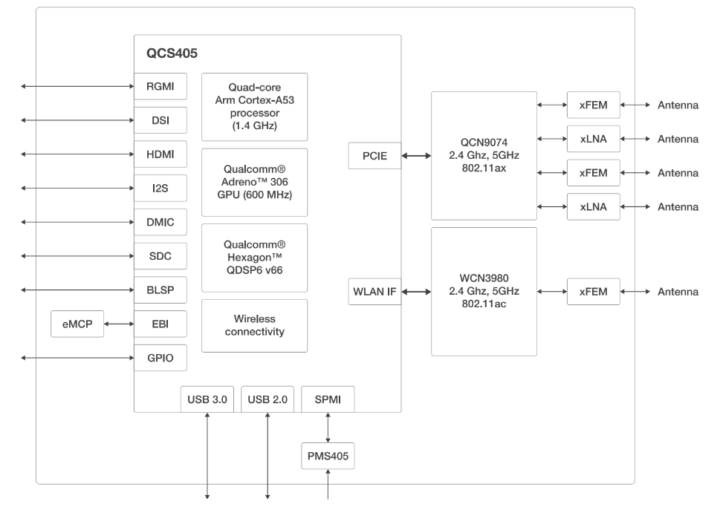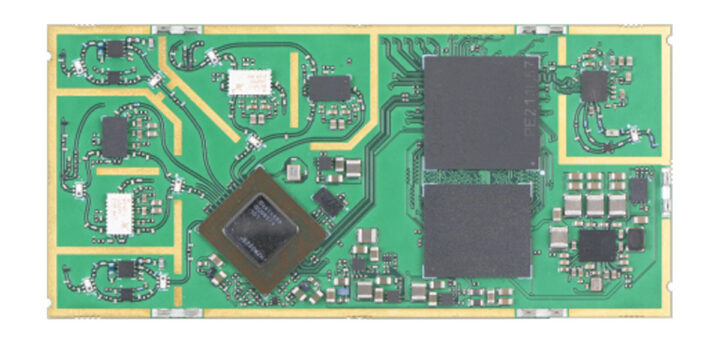8devices has recently introduced TobuFi, a Qualcomm QCS405-powered System-on-Module (SoM) featuring dual-band Wi-Fi 6 and Wi-Fi 5 capabilities. The device also features 1GB LPDDR3, 8GB of eMMC storage, and multiple display resolutions. It also offers various interfaces, including USB 3.0, HDMI, I2S, DMIC, SDC, UART, SPI, I2C, and GPIO.
In previous posts, we covered 8devices product launches like the Noni M.2 WiFi 7 module, Rambutan and Rambutan-I modules, Habanero IPQ4019 SoM, Mango-DVK OpenWrt Devkit, and many more innovative products. If you’re interested in 8devices, feel free to check those out for more details.
8devices TobuFi SoM specifications:
- SoC – Qualcomm QCS405
- CPU – Quad-core Arm Cortex-A53 at 1.4GHz; 64-bit
- GPU – Qualcomm Adreno 306 GPU at 600MHz; supports 64-bit addressing
- DSP – Qualcomm Hexagon QDSP6 v66 with Low Power Island and Voice accelerators
- Memory – 1GB LPDDR3 + 8GB eMMC
- Storage
- 8GB eMMC flash
- SD card – One 8-bit (SDC1, 1.8V) and one 4-bit (SDC2, 1.8/2.95V)
- Display Interfaces
- 4-lane MIPI DSI port supports up to 720p
- HDMI 1.4a, supports up to 1080p at 30fps
- General RGB and SPI support
- Ethernet – RGMI interface
- Wireless
- Wi-Fi
- Qualcomm QCN9074 Wi-Fi 6 (802.11a/g/n/ac/ax); Dual-band 2.4GHz and 5GHz; MU-MIMO 20/40/80/160MHz; Up to 28dBm at 2.4GHz, 27dBm at 5GHz AND
- Qualcomm WCN9380 Wi-Fi 5 (802.11a/g/n/ac); Dual-band 2.4GHz and 5GHz; MU-MIMO 20/40/80; Up to 22dBm at 2.4GHz, 20dBm at 5GHz
- Bluetooth – Bluetooth 5.0 with FM RDS/RBDS
- Wi-Fi
- USB – USB 2.0 and USB 3.0 ports
- Additional Interfaces – I2S, DMIC, SDC, UART, SPI, I2C, GPIO
- Dimensions – 36.6 x 76.6 mm
While I was looking at the specifications, I wondered why the SoM features two radio modules. It turns out that the QCN9074 radio module provides a host of neat features. It operates on dual-band 2.4 GHz and 5 GHz frequencies with a 2×4 antenna setup and supports extended frequency ranges from 2312-3000 MHz and 4900-5925 MHz. This setup is crucial for that 5/10MHz narrow bandwidth support that extends the range of the device to 10 kilometers and beyond.
The module also reduces channel steps to 1 MHz for both the 2.4 GHz and 5 GHz bands, enhancing precision in frequency selection. Furthermore, it uses non-standard center frequency channels to minimize interference, enhancing the stability and reliability of wireless connections for various applications.

To get started with this SoM the company offers a development Kit along with a details page, where you can find all the essential components of the board.

8devices also provides a datasheet and a product brief for the SoM. The datasheet includes a Block Diagram of the SoM, which is very useful when working with the device.
The TobuFi software is based on OpenEmbedded/Yocto, providing a flexible platform with essential tools and packages for easy customization. The SDK includes image recipes for developing custom applications and system setups, while integrated ADB tools and fast boot support simplify the development process. You can find more details on the GitHub page.
At the time of writing, the 8devices TobuFi SoM is available for preorder at $159.00, while the Development Kit can be preordered for $399.00. The company mentions that the SoM will be ready for delivery by June 2024.
Debashis Das is a technical content writer and embedded engineer with over five years of experience in the industry. With expertise in Embedded C, PCB Design, and SEO optimization, he effectively blends difficult technical topics with clear communication
Support CNX Software! Donate via cryptocurrencies, become a Patron on Patreon, or purchase goods on Amazon or Aliexpress. We also use affiliate links in articles to earn commissions if you make a purchase after clicking on those links.





what is a voice accelerator ?
It is a specialized hardware for voice recognition, noise suppression, and audio signal processing while maintaining a low overall power consumption. for voices assisted battery power smart home devices.
It’s the first time CNX publish something about WAR.
Seriously disapointed !
How it is related to war?
The Electronic one.
Hi Debashis ,
Where can I find you in Linkedin?